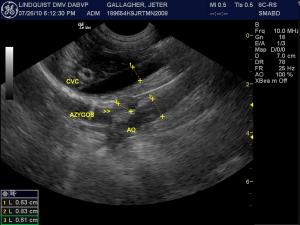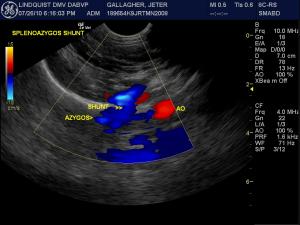Clinical Differential Diagnosis
(Remo Lobetti BVSc, MMedVet, PhD, DECVIM):
http://www.sonopath.com/Specialists_Lobetti.html:
Vomition – infectious (viral, bacterial, helminths), diet, toxins, garbage disease, liver disease
Liver disease – congenital (MVD, PSS), cirrhosis
Sonographic Differential Diagnosis
(Lindquist DMV, DABVP): Extra hepatic shunt bypassing the vena cava consistent with splenoazygos shunt. Surgically correctable. Potential for concurrent microvascular dysplasia.
Sampling
Full-thickness surgical biopsies of the liver showed hepatic microvascular dysplasia. Culture of the bladder wall yielded no growth.
Outcome
The patient was recommended for urinary bladder lavage, ameroid constrictive placement upon the extra-hepatic spleno-azygos shunt, and concurrent liver biopsy. On exploratory surgery, a large splenoazygos shunt was identified and attenuated with an ameroid constrictor, liver biopsies were taken, a cystotomy was performed, and a culture from the bladder wall was obtained. The patient was discharged with Clavamox, Tramadol, and recommended for a special low protein liver diet. At last communication the owner reported the patient doing well.




Comments